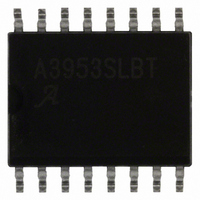A3953SLBTR-T Allegro Microsystems Inc, A3953SLBTR-T Datasheet - Page 9

A3953SLBTR-T
Manufacturer Part Number
A3953SLBTR-T
Description
IC MOTOR DRIVER PWM FULL 16-SOIC
Manufacturer
Allegro Microsystems Inc
Datasheet
1.A3953SLBTR-T.pdf
(12 pages)
Specifications of A3953SLBTR-T
Applications
PWM Motor Driver
Number Of Outputs
1
Current - Output
±1.3A
Voltage - Load
3 V ~ 50 V
Voltage - Supply
3 V ~ 5.5 V
Operating Temperature
-20°C ~ 85°C
Mounting Type
Surface Mount
Package / Case
16-SOIC (0.300", 7.5mm Width)
Motor Type
Full Bridge
No. Of Outputs
1
Output Current
1.3A
Output Voltage
50V
Supply Voltage Range
3V To 5.5V
Driver Case Style
SOIC
No. Of Pins
16
Lead Free Status / RoHS Status
Lead free / RoHS Compliant
Other names
620-1133-2
A3953SLBTR-T
A3953SLBTR-T
Available stocks
Company
Part Number
Manufacturer
Quantity
Price
Part Number:
A3953SLBTR-T
Manufacturer:
ALLEGRO/雅丽高
Quantity:
20 000
A3953
value of t
occurs each time the PWM latch is reset. If the motor is not
rotating (as in the case of a stepper motor in hold/detent mode, a
brush dc motor when stalled, or at startup), the worst case value
of current regulation can be approximated by:
where t
V
the Electrical Characteristics table. When the motor is rotating,
the back EMF generated will influence the above relationship.
For brush dc motor applications, the current regulation is
improved. For stepper motor applications, when the motor is
rotating, the effect is more complex. A discussion of this subject
is included in the section on stepper motors below.
The following procedure can be used to evaluate the worst-case
slow current-decay internal PWM load current regulation in the
system:
1. Set V
current control operating in slow current-decay mode, use an
oscilloscope to measure the time the output is low (sink on) for
the output that is chopping. This is the typical minimum on time
(t
2. The C
of t
characteristics table.
3. When the new value of C
be decreased so the value for t
increased value of C
4. The worst-case load-current regulation then can be measured
in the system under operating conditions.
PWM of the PHASE and ENABLE Inputs.
PHASE and ENABLE inputs can be pulse-width modulated
to regulate load current. Typical propagation delays from the
PHASE and ENABLE inputs to transitions of the power outputs
are specified in the electrical characteristics table. If the internal
PWM current control is used, the comparator blanking function
is active during phase and enable transitions. This eliminates
false tripping of the over-current comparator caused by
switching transients (see RC Blanking section, above).
Enable PWM.
ENABLE input turns on and off the selected source and sink
drivers. The corresponding pair of flyback and ground-clamp
I
ON(min)
BB
AVE
ON(min)
is the motor supply voltage and t
≈
OFF
REF
typ) for the device.
T
OFF
then should be increased until the measured value
is equal to t
= R
[(V
to 0 volts. With the load connected and the PWM
and the minimum on-time pulse t
BB
T
– V
x C
With the MODE input low, toggling the
SAT(source+sink)
T
T
, R
) is equal to the nominal design value.
ON(min)
LOAD
1.05 x (t
T
max as specified in the electrical
) x t
is the series resistance of the load,
has been set, the value of R
OFF
ON(min)
ON(min)
= R
max + t
max] – (1.05(V
T
ON(min)
x C
OFF
T
(with the artificially
max is specified in
) x R
ON(min)
LOAD
SAT(sink)
max that
The
+ V
T
F
should
) x t
OFF
)
diodes conduct after the drivers are disabled, resulting in fast
current decay. When the device is enabled the internal current-
control circuitry will be active and can be used to limit the load
current in a slow current-decay mode.
For applications that PWM the ENABLE input and desire the
internal current-limiting circuit to function in the fast decay
mode, the ENABLE input signal should be inverted and
connected to the MODE input. This prevents the device from
being switched into sleep mode when the ENABLE input is low.
Phase PWM.
sink/source pair is enabled, producing a load current that varies
with the duty cycle and remains continuous at all times. This
can have added benefits in bidirectional brush dc servo motor
applications as the transfer function between the duty cycle on
the PHASE input and the average voltage applied to the motor is
more linear than in the case of ENABLE PWM control (which
produces a discontinuous current at low current levels). For more
information see DC Motor Applications section, below.
Synchronous Fixed-Frequency PWM.
PWM current-control circuitry of multiple A3953 devices can
be synchronized by using the simple circuit shown in figure 3.
A 555 IC can be used to generate the reset pulse/blanking signal
(t
value of t
configuration, the R
The PHASE and ENABLE inputs should not be PWM with this
circuit configuration due to the absence of a blanking function
synchronous with their transitions.
Miscellaneous Information.
the ENABLE and MODE terminals puts the device into a sleep
mode to minimize current consumption when not in use.
An internally generated dead time prevents crossover currents
that can occur when switching phase or braking.
Full-Bridge PWM Motor Driver
1
) for the device and the period of the PWM cycle (t
Synchronous Fixed-Frequency Control Circuit
t
t
2
1
1
should be a minimum of 1.5 ms. When used in this
Toggling the PHASE terminal selects which
T
and C
115 Northeast Cutoff
1.508.853.5000; www.allegromicro.com
Allegro MicroSystems, Inc.
Worcester, Massachusetts 01615-0036 U.S.A.
T
Figure 3
components should be omitted.
2N2222
V
CC
A logic high applied to both
1N4001
The internal
2
). The
Dwg. EP-060
RC
RC
1
N
8
















